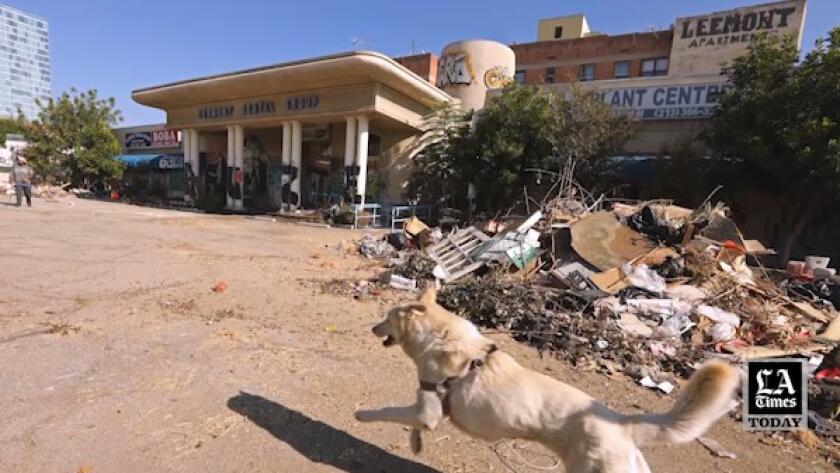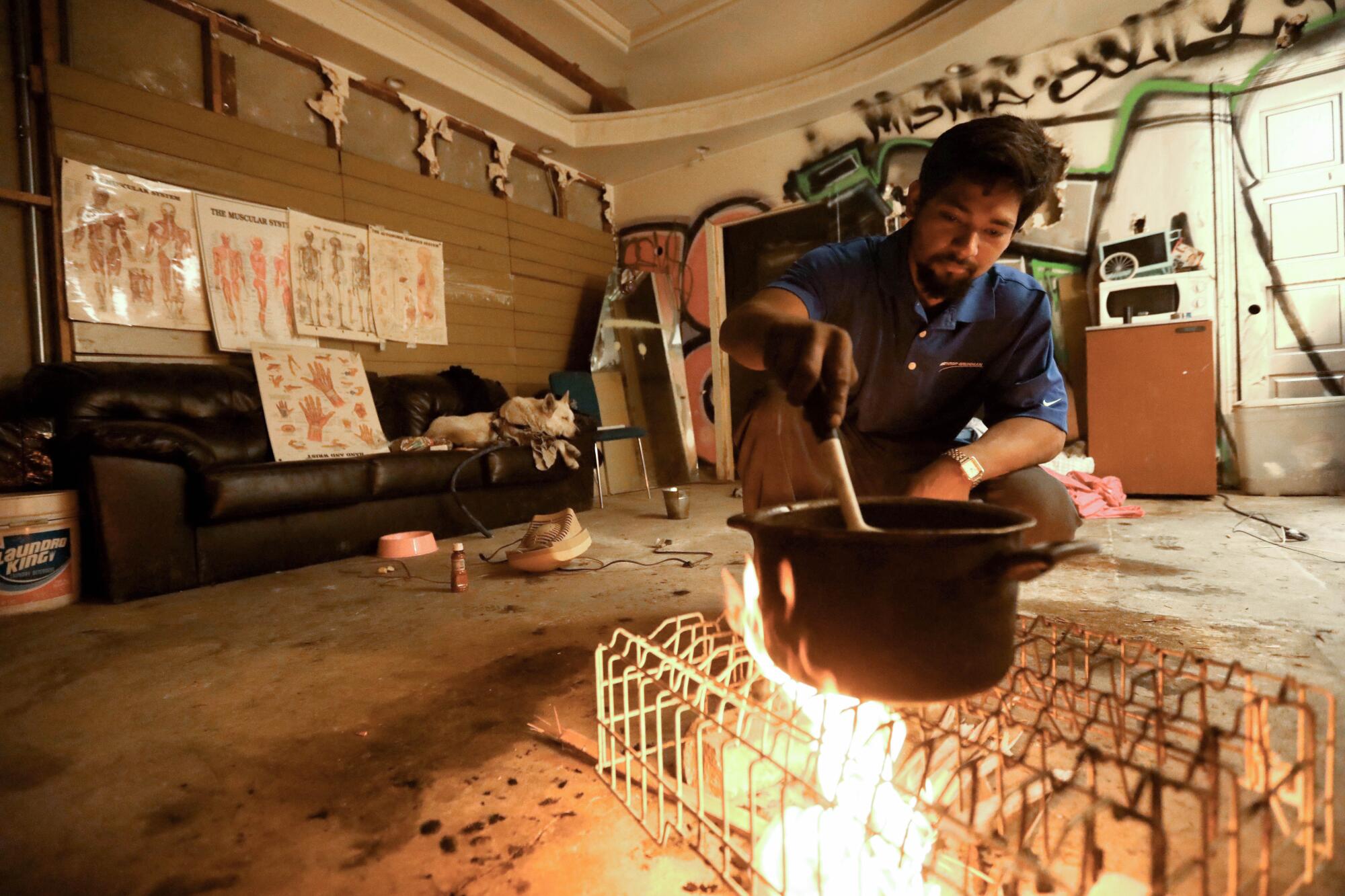
- Share via
To enter 732 S. Vermont Ave., you must carefully shove open a rusted gray iron gate until a gap large enough for you to slide through sideways appears.
If you delicately step your way through the onetime parking lot littered with mounds and mounds of trash — a stained mattress here, a toilet there — you’ll approach a graffiti-covered building with a large sign: Vermont Dental Group Implant Center.
And if you stick around for a while, you might see the people who called it home. In a city with homeless encampments popping up in parks, on sidewalks and under overpasses, a tiny and mostly unnoticed community took hold here, two blocks away from sleek Wilshire Boulevard apartments, finding shelter within the derelict building’s dusty, wire-exposed walls.
::
The main entrance is blocked, somewhat, by planks of plywood leaning against the doorframe, but it’s easy to squeeze through.
The first door on your left: Cuba and Sergio’s room.
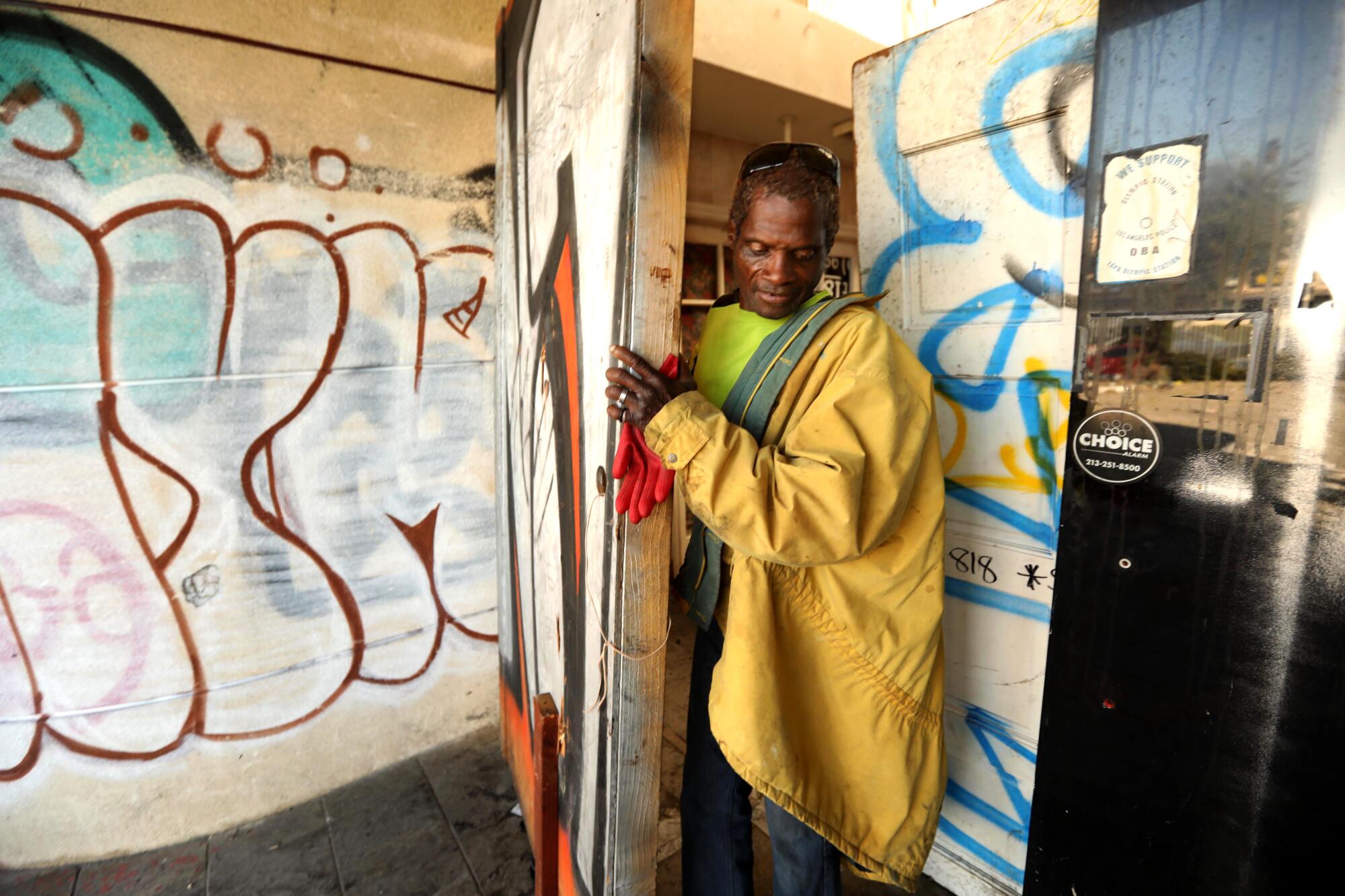
The couple met in MacArthur Park eight years ago, and their barely twin-size canopied bed was placed against one wall with fairy lights draped above it. A small yucca plant was growing in a plastic bottle. A shopping cart brimming with recyclables sat near the entrance of the room.
On one Tuesday morning, Cuba was busy cleaning.
He lifted one corner of a sheet of metal from the ground to reveal a gaping hole in the floorboards. Then he swept, sending dirt and debris into the hole.
His name is Felipe Diaz Acosta, but everyone calls him Cuba, he said, because he came to the U.S. from the island in 1982. He was just 13 when he got on a large shipping boat and landed on the shores of Florida.
“Me and my mother don’t get along,” he said. “She doesn’t want everyone to know I’m gay — beat me to change me.”
What followed was a foster home and then a succession of restaurant and cleaning jobs that took him to Pennsylvania. It wasn’t to his liking. Too cold, and he hated the snow.
Then he saw a commercial advertising, “California, California nice and hot!” and made up his mind. I’m going to California. And he did.
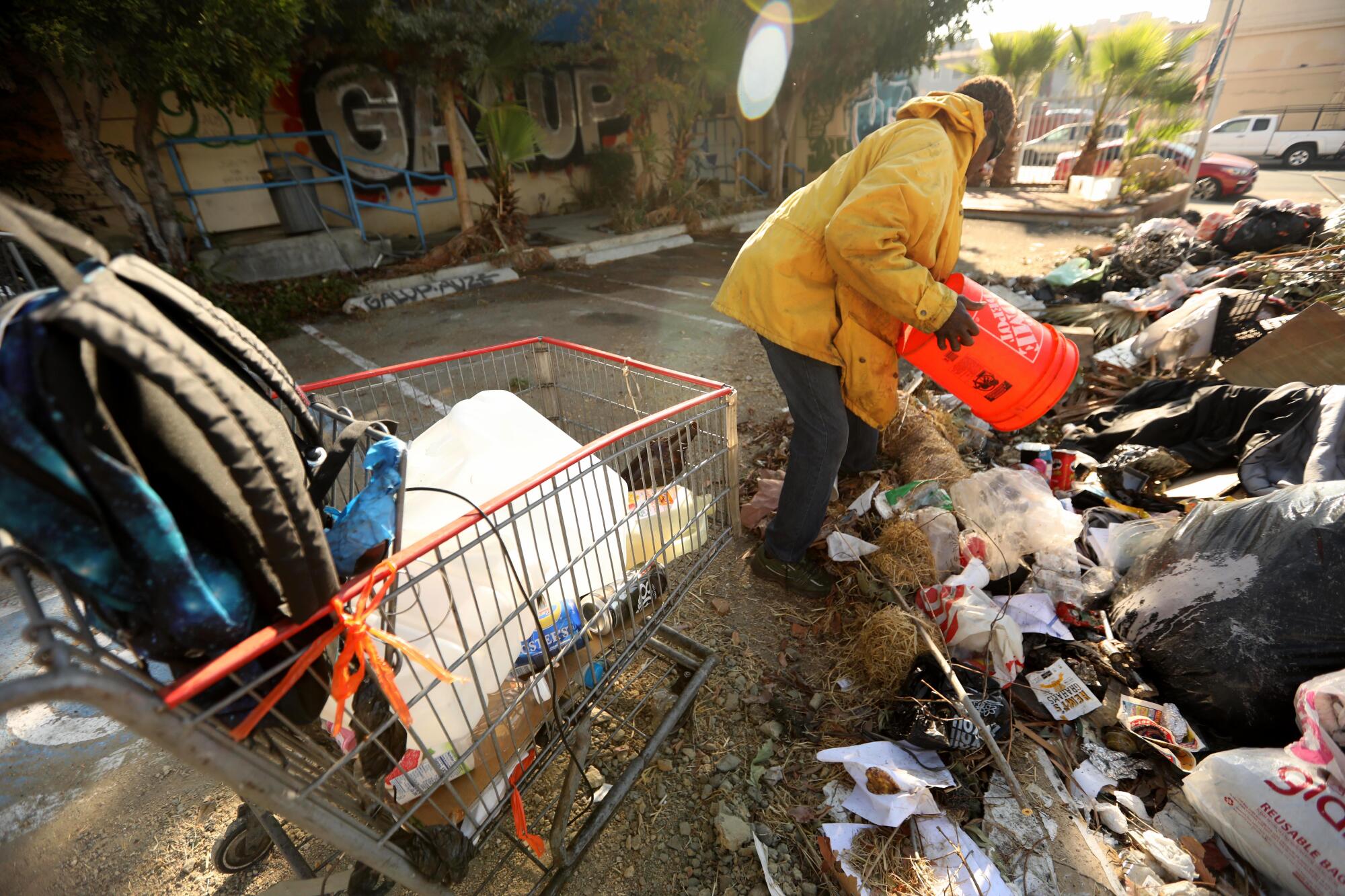
After tidying up the room and doing a final once-over, the 52-year-old was done chit-chatting and impatient to start his day, collecting recyclables.
Sergio stays behind to prevent their belongings from being set on fire or stolen by intruders. He tends to fixate on objects and often lingers around the building tenderly cupping a small rock in his hands.
On a good day, Cuba can get $40 to $50 for a full cart. But timing is key.
“If you start work early, you make money. If you start work late, you make no money,” Cuba said. He put on a yellow jacket, sunglasses and rubber gloves and hauled the shopping cart out of their room.
::
Through the swarm of flies patrolling what once was a dentist’s waiting room, a hallway on the left leads to a large room on the north end of the building. The muted sounds of Latin pop echo down the hallway as you approach.
This is Alex Seijas-Torres’ room.
A lighthearted warning in Spanish appears on the wall outside: “Don’t enter my room because the dog is loose.”
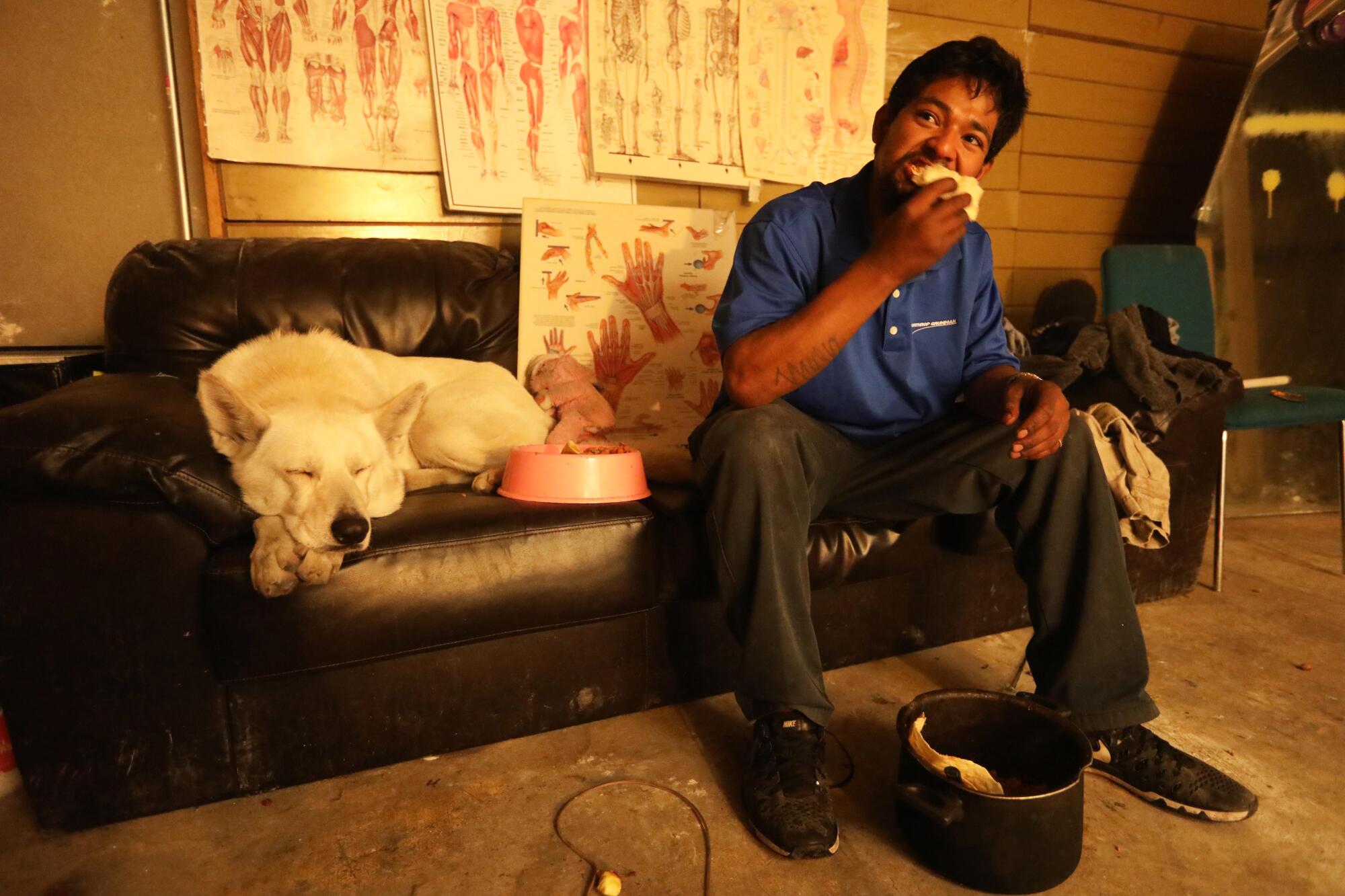
Multiple visits with Alex revealed a room that seemed to be in a constant state of redecorating. Couches appeared and disappeared. Furniture got rearranged. One day there were medical anatomy posters on the walls; another day, they’re gone.
The only constant is a large, white fluffy dog usually snoring in the corner. Alex said she’s a wolf, not a dog, and calls her Loba.
Alex likes to decorate — and redecorate — his space with anything interesting he finds thrown away. But it’s hard to keep your belongings safe when you don’t have a lock on your door, he explained. Sometimes people come and take things, but Alex shrugs it off. It’s the nature of his life.
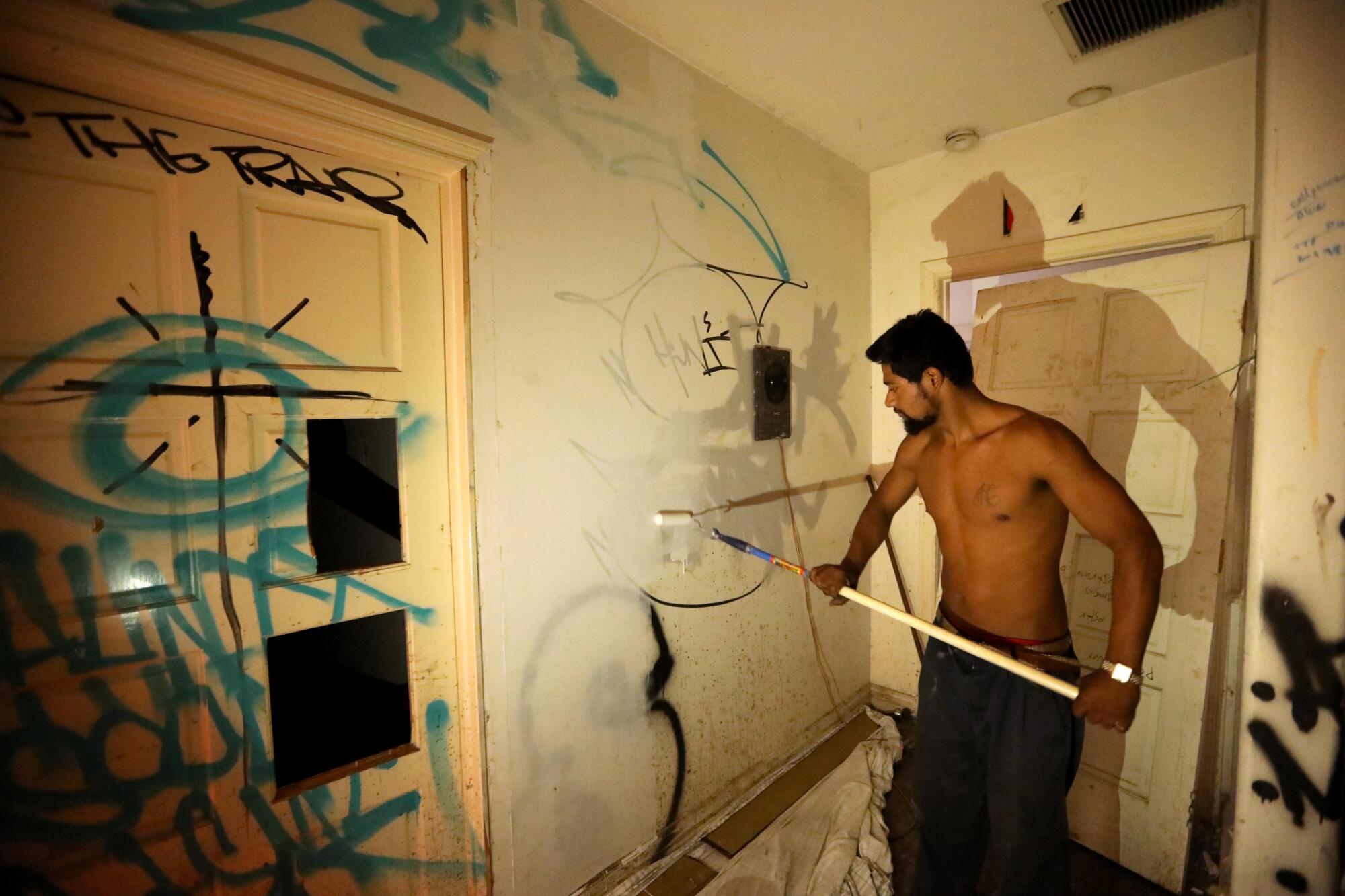
In 2009, he came to the U.S. from Guatemala with his sisters and mother to go to school, while his father stayed behind. The 12-year-old didn’t know any English, and he didn’t like school. He stopped going after two years, he said, so his mom told him: “You work, you pay rent.”
It was around that time, Alex said, that he started using meth. He’s been homeless on and off since.
His sisters and mother both live only a few blocks away from the Vermont building, but he’s reluctant to stay with them.
“I don’t want to get my family in trouble with my problems,” Alex said. “My problems is my problems. My life is my life.”
Alex had only been living in the building for a few months, but he’s responsible for the biggest change for its residents: electricity.
“When I came in here, everything is black,” Alex said. “No light, no water. Everybody got electricity from me.”
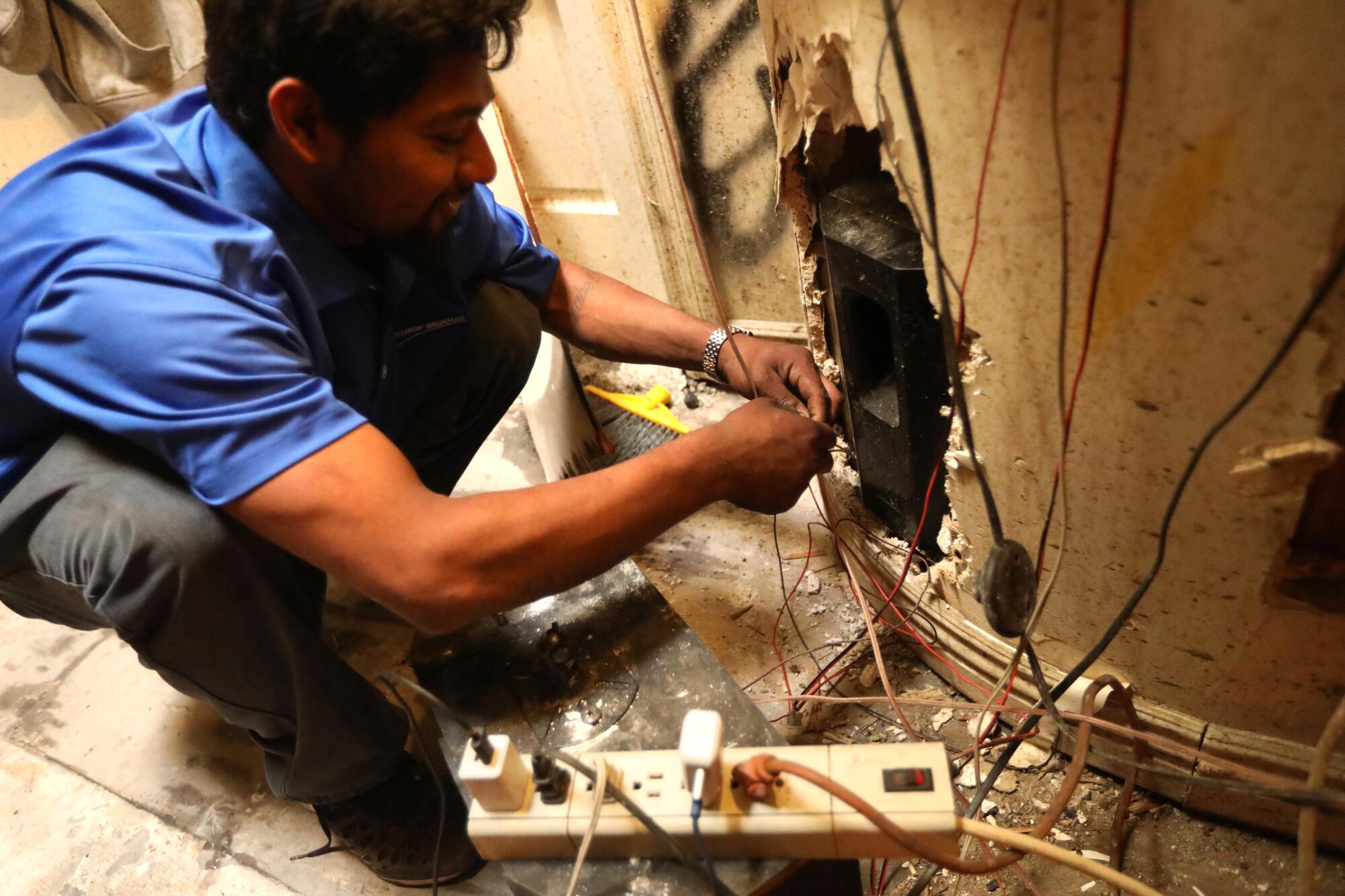
After discovering wires with live current sprouting from the ground outside the northwest corner of the building, the savvy 24-year-old set to work: black wire to black, white wire to white. Soon a delicate system of cords delivered power across the building.
Any mishap causes the whole system to short-circuit.
“When I connect to all the house, it exploded,” Alex said.
Having electricity meant he could charge his phone, string Christmas lights in the rafters, and plug in speakers placed in the four corners of the room that blare out songs such as “Llorar” by Los Socios Del Ritmo or “Experimento” by Myke Towers.
Alex spends most of his days cleaning and decorating his space, or gathering more gadgets he finds outside.
“I know I’m from the streets, but I like everything clean, you know?”
A small, dusty fridge held a few cans of soup, a bowl of cooked ham mixed with dog food, and half a raw turkey stuffed in the icebox. Above it sat a microwave he uses to warm up tortillas — but the fridge has to be unplugged for him to run it.
Sometimes he buys food with the little money he makes by doing odd jobs, like cleaning for the businesses across the street. Other times, his mother stops by with pupusas. One morning in November, his sister brought a bag of white bread, a dozen eggs and a stack of tortillas.
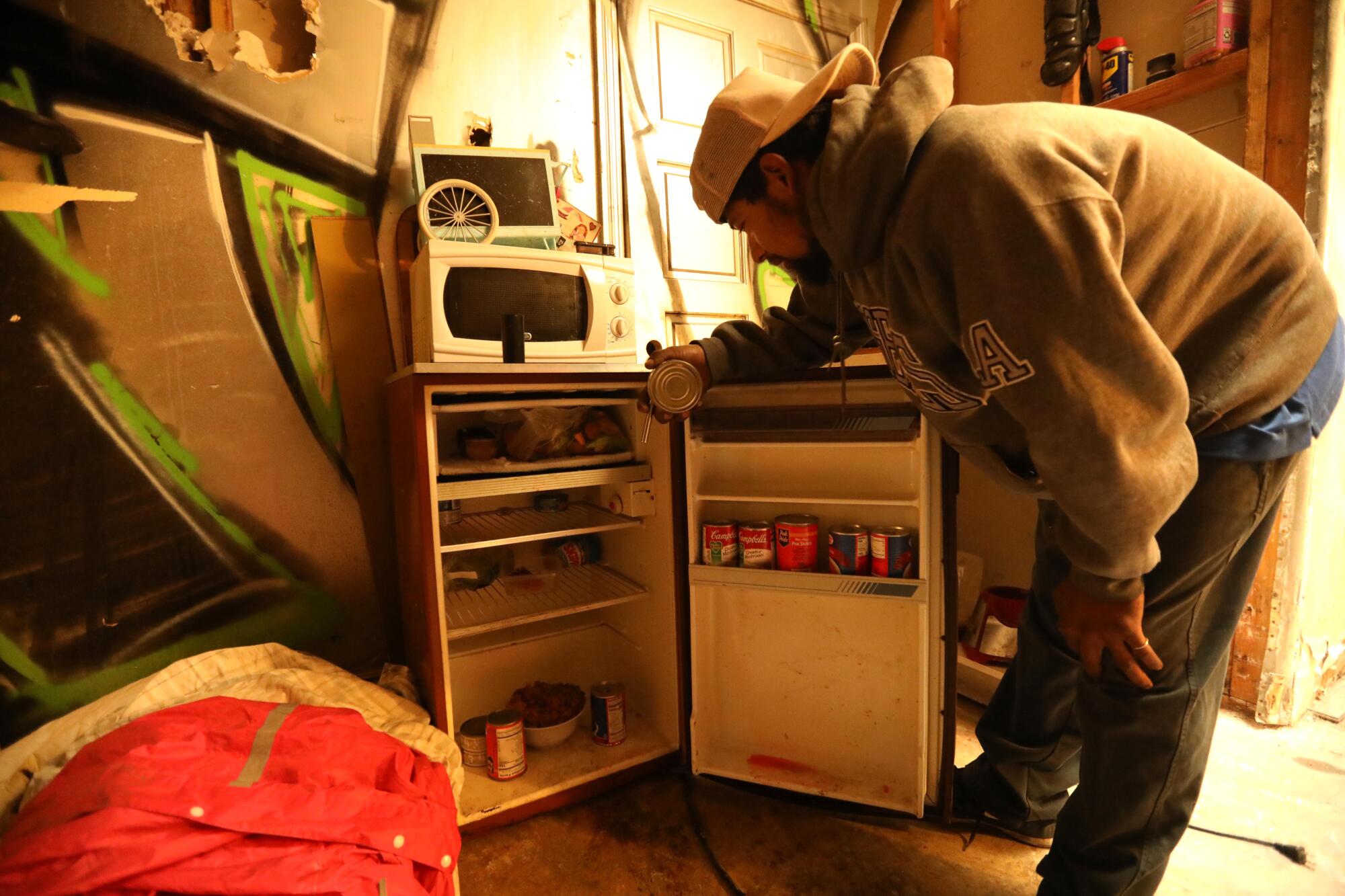
He usually used a gas stove to cook eggs, but that day he needed to start a fire — he was out of money to buy gas.
“Mafia! Lighter?” Alex yelled out the door. The resident known as Mafia, a solemn man in a baseball cap, walked in and handed him a lighter.
Using a small ax, Alex carefully split chunks of wood and arranged them in a circle, fanning out like a small teepee. He grabbed a white plastic bowl and set it aflame.
Noxious fumes filled the room as white globs of melted plastic dripped down onto the wood, catching it on fire. The smell mixed with the scents of egg and ham being heated in a pot, something Alex had cooked a few days prior.
“Yesterday when I was cooking, I burned my hand,” Alex said. The pot was precariously perched on an upturned dish-drying rack over the fire.
“Mafia! Taco?” he yelled out the door. Mafia appeared in the doorway again but declined. He had been cleaning, and his hands were dirty, he said.
When the food was ready, Alex scooped it up with the newly acquired tortillas. He took a bite, but alternated with feeding Loba. She eats whatever he eats, he said.
::
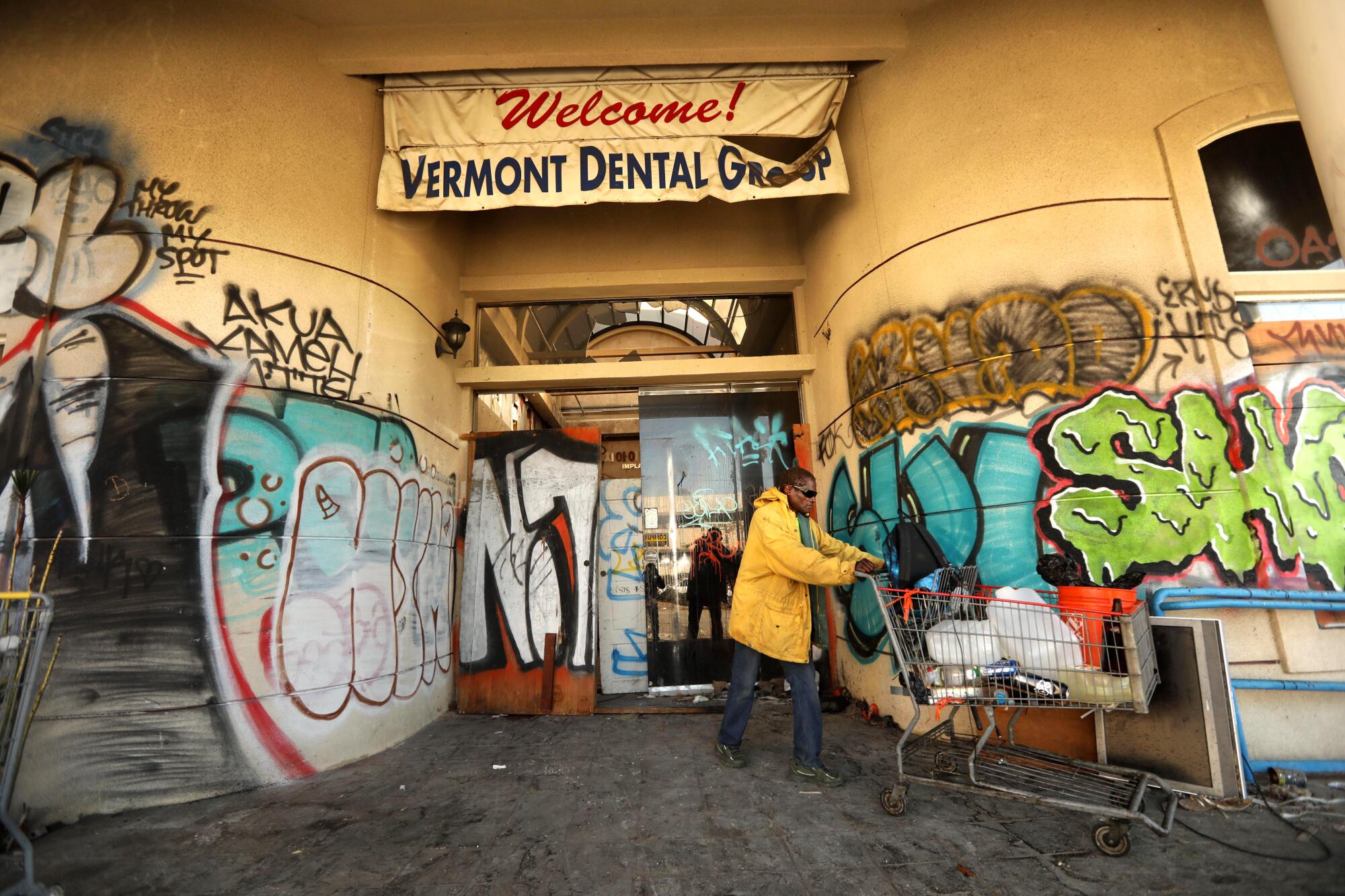
The two red paper fliers appeared on Nov. 13, 2021, and even included, in military time, when they were posted on the building, 13:08 hours. They read: “UNSAFE DO NOT ENTER OR OCCUPY.”
It made the residents uneasy.
“If the city takes it, I don’t know where I’ll go to,” Alex said. “This is my home, this is my place.”
Some building residents are regulars; others drift in and out. There’s George, known affectionately as Tata, who takes care of a disabled woman called Wicky. There’s Edgar, who prefers the sidewalk next to the building over being indoors and is longtime friends with Carla, a woman known to have a temper.
Then there’s Gabriel. When he became homeless about eight years ago, his ex-wife took both their kids and moved to Chicago. He’s been trying to get off meth.
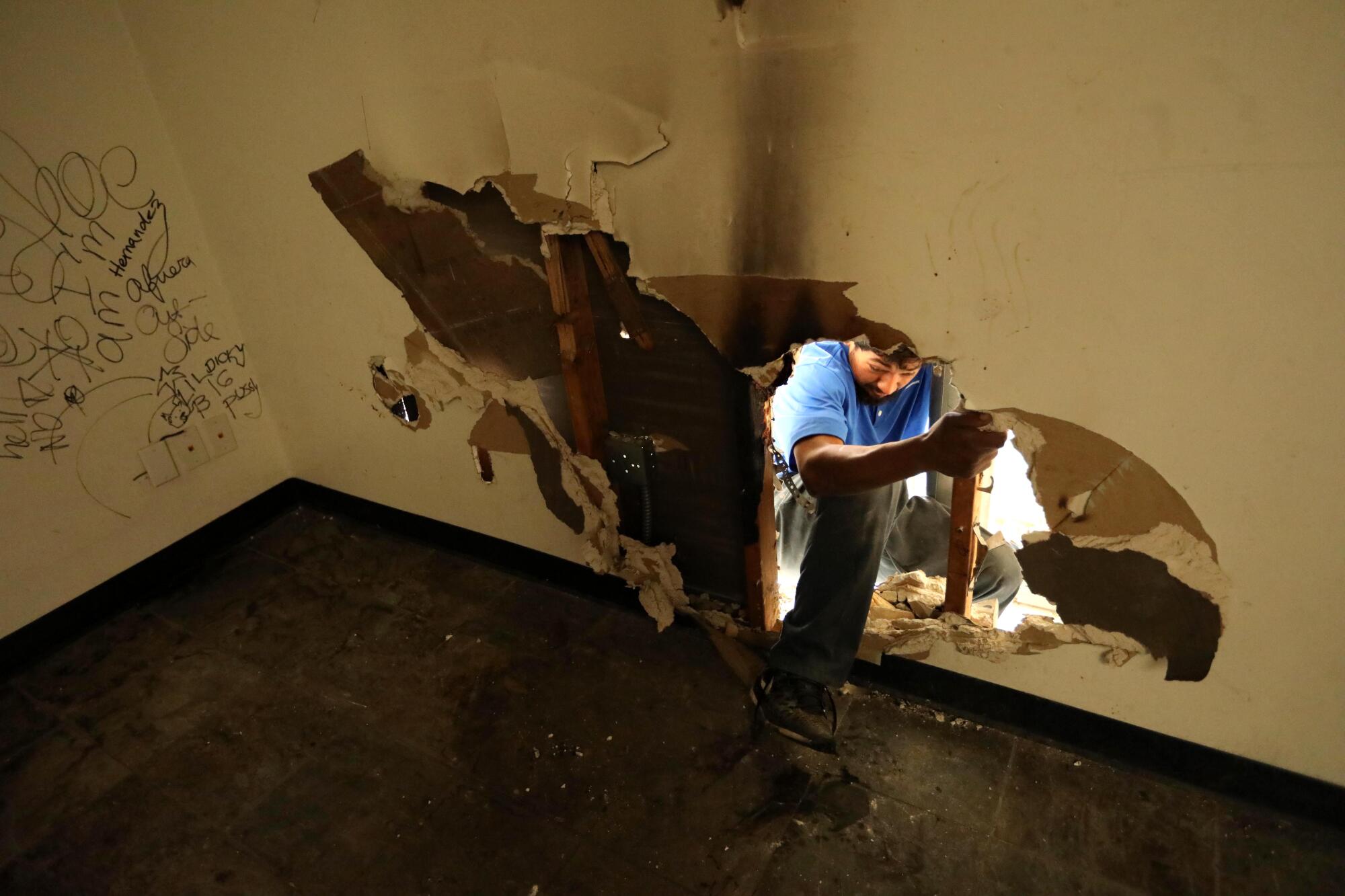
“I’m happy here,” Gabriel said. “It may not look like it, but I’m generally happy.”
The residents theorized social workers would arrive and gently prompt them out of their homes. But weeks went by. No one came. The residents tore down the red fliers, and soon forgot about them.
The building, constructed in 1999, was purchased in February 2020 by 730 Vermont Venture LLC for more than $10 million.
In May 2021, the Los Angeles Planning Department approved plans for a seven-story, 80-unit mixed-use project there. The building will include 40 studio apartments, 69 automobile parking spaces and 76 bicycle stalls, the plans say. The developer could not be reached for comment.
The proposal is part of the city’s Transit Oriented Communities program, which allows developers to propose higher-density projects depending on proximity to transit if they keep some units affordable for people with extremely low incomes.
::
After sharing his tacos with Loba, it was time for her bath. Alex wheeled a blue recycling bin — the kind left at the curb — out of his room to reach the water room on the other side of the building.
On his way, he stopped by Cuba’s place to borrow some soap.
Cuba, just back from collecting recyclables, was slightly sweaty from being out in the sun. He was cleaning again, singing loudly to “Culpables” playing on his radio while he swept.
“Cleaning so you don’t get sick,” he said. “Otherwise, you get sick.”
Residents had discovered they could coax water from the building’s fire sprinklers, but they had to be careful. Crank a pump too much, and the water goes on everywhere. A delicate touch means only three sprinklers will turn on.
‘I know I’m from the streets, but I like everything clean, you know?’
— Alex Seijas-Torres
Alex placed the blue bin under a sprinkler to collect some water. It started as a brown trickle. He rolled the bin to the foyer, where he scooped out water to wash Loba, scrubbing her down with a fragrant sea kelp and hyaluronic acid body wash.
Mafia came by to light a cigarette for Alex, which he gladly accepted, and Cuba came out of his room to throw a light-up squeaky ball for the dog. They all love Loba.
Alex gave her a final, loving rinse before leading her to his room, where she maniacally dried herself off on his mattress.
Loba, a gift from an ex-girlfriend, is another reason why Alex was living here.
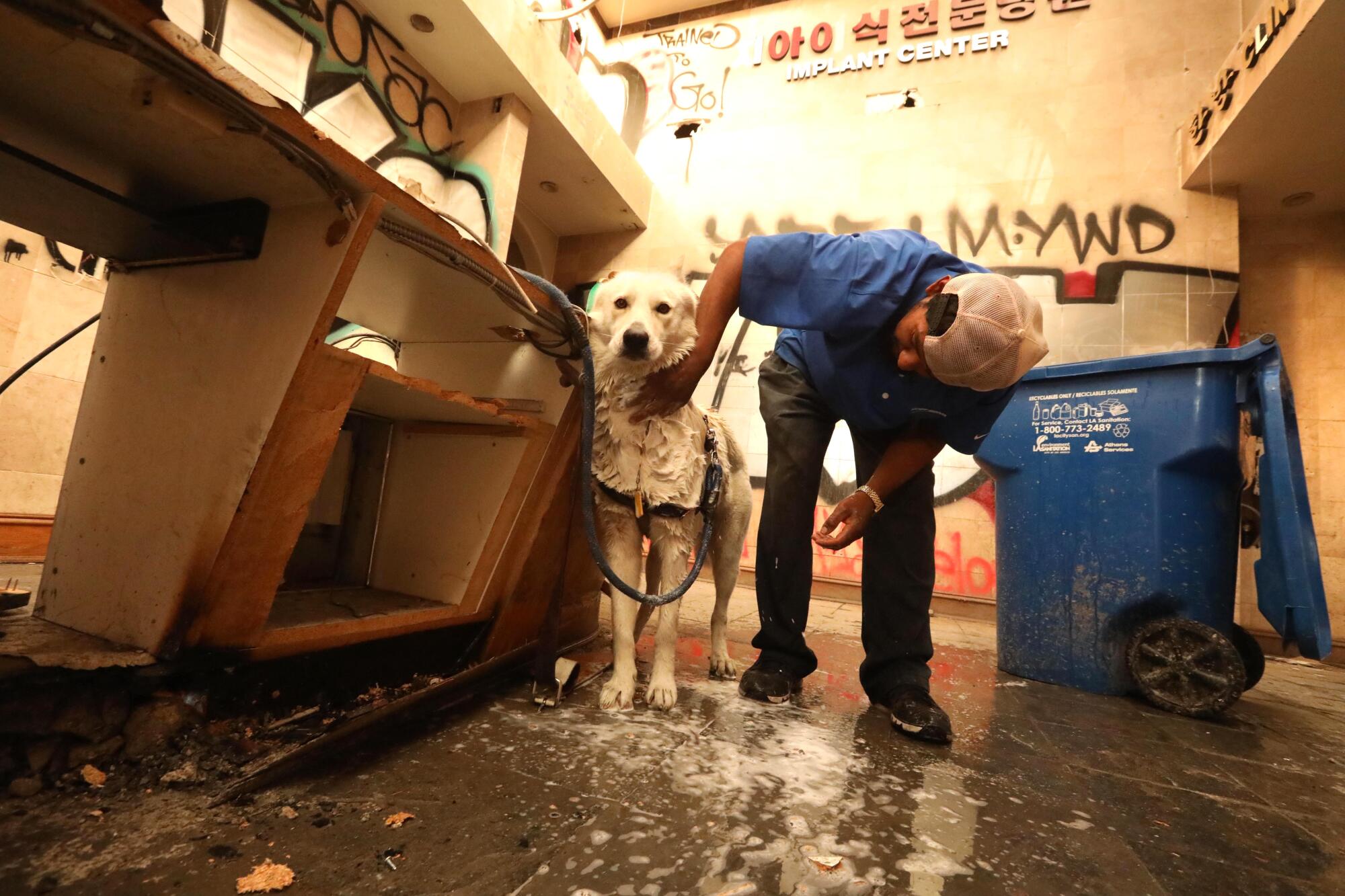
It’s difficult to find an affordable apartment that will accept her. The last time he spoke to his sister, he turned down her offer of a place to stay in Pasadena because he couldn’t bear to leave Loba.
For Loba, he’s trying to stay out of trouble and out of jail; the last time he left jail was Feb. 11, 2021. He’s been in jail six times, he said, all for car-theft-related arrests.
He’s also trying to stay sober from crystal meth, which has invaded his life, time and time again since he was 14. All, he said, for Loba.
::
Mafia’s real name is Joe Alexander Gomez.
It’s a fact he reveals only at the end of several conversations, after he deems you credible enough to entrust with that information. Though some, like Alex, call him Mafia, most know him, if they know him at all, as Joe.
He moved into the building in late November. His space was filled with bicycle parts, wheels hung up on the walls and bare metal frames collecting dust in the corners of the room.
He likes fixing bikes, he said. Maybe he’ll open his own shop someday.
Joe became homeless about two years ago, shortly after the death of his partner — a beautiful Venezuela girl, he called her — and their baby girl during childbirth.
“I don’t know if it was something from the sky I was punished for,” he said.
For a while, he lived in front of the Wilshire Tower until he made his way to the Vermont building. His younger brother used to see a dentist here.
He seemed more mindful of his safety than other residents. He pointed out a wooden bar he affixed to his door that rattles loudly on the floor if anyone tries to open it while he is asleep.

This he attributed to being ex-military, speaking in a low whisper. He doesn’t like to go into the details.
He has a son from a previous relationship who recently turned 12 and lives with his mom, though Joe hadn’t seen him for nearly a year.
Joe also struggles with crystal meth, which he likes to call “candy.” It keeps the residents of the building up all night and often several days in a row. He calls them “my people” and said he felt responsible for taking care of them.
“The good thing about being on the street is the unity of people,” Joe said. “Sometimes your blood family is not your family.”
But a few months later, Joe had grown weary of his new neighbors after getting into an “issue of disrespect” with one of them, a resident said. He moved out to a tent encampment on Olympic Boulevard.
::
The acrid smell of smoke was nauseating.
The building’s entrance, no longer obstructed by any barriers, revealed the blackened interior of the main foyer devastated by a blaze that swept through on Monday.
“It was a real heated fire,” Edgar said two days after the fire. “Real hot.”
No one knows exactly how it started. One resident this week blamed the improvised electrical system, while others pointed fingers at a resident who fled as soon as it started around 5 a.m. The fire took about 35 minutes to extinguish, and the cause is still under investigation.

Cuba and Sergio’s room was mostly spared by the flames, but Cuba said they plan to leave as soon as they find a better place to live.
Alex and Loba have already left.
Those who camped out here, both inside and nearby, knew their time was coming to an end. A demolition permit issued in December will expire soon, so the building will indeed come down, possibly in days.
The fire just kicked out some residents a few days early. But they’ll find somewhere else to live, like they always do.
Staff writer Andrew J. Campa contributed to this report.
- Share via
Watch L.A. Times Today at 7 p.m. on Spectrum News 1 on Channel 1 or live stream on the Spectrum News App. Palos Verdes Peninsula and Orange County viewers can watch on Cox Systems on channel 99.
More to Read
Sign up for Essential California
The most important California stories and recommendations in your inbox every morning.
You may occasionally receive promotional content from the Los Angeles Times.
